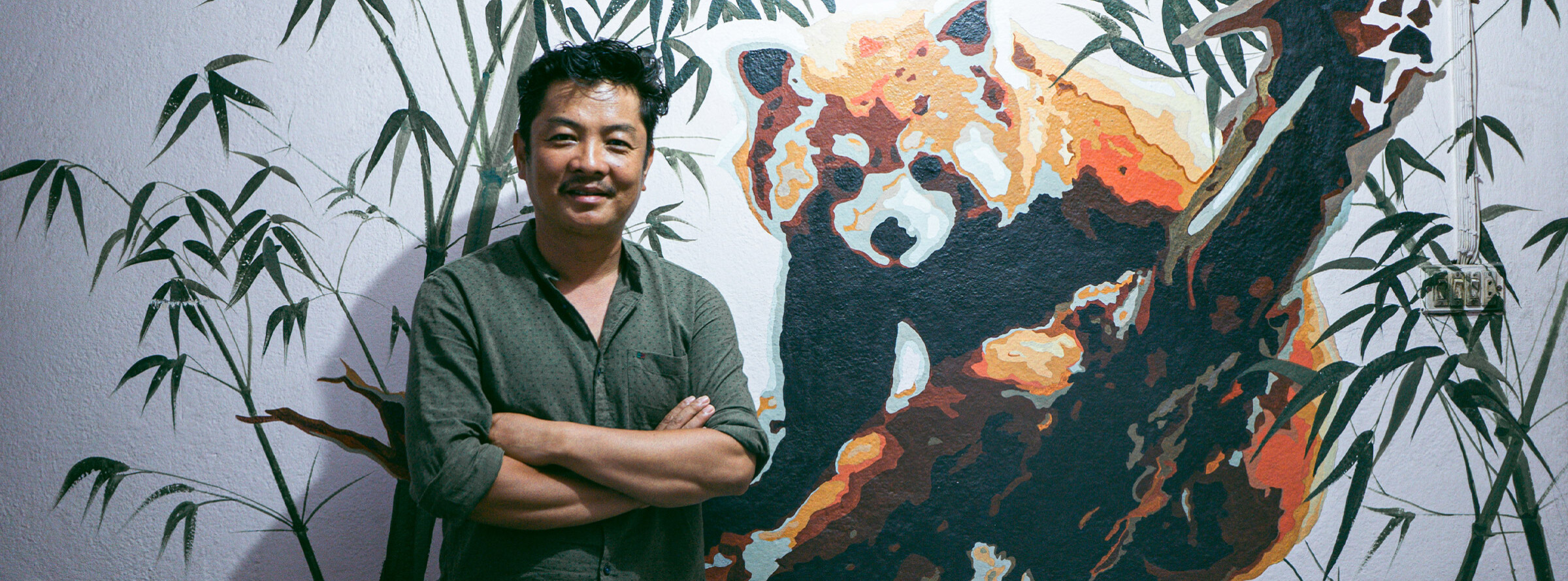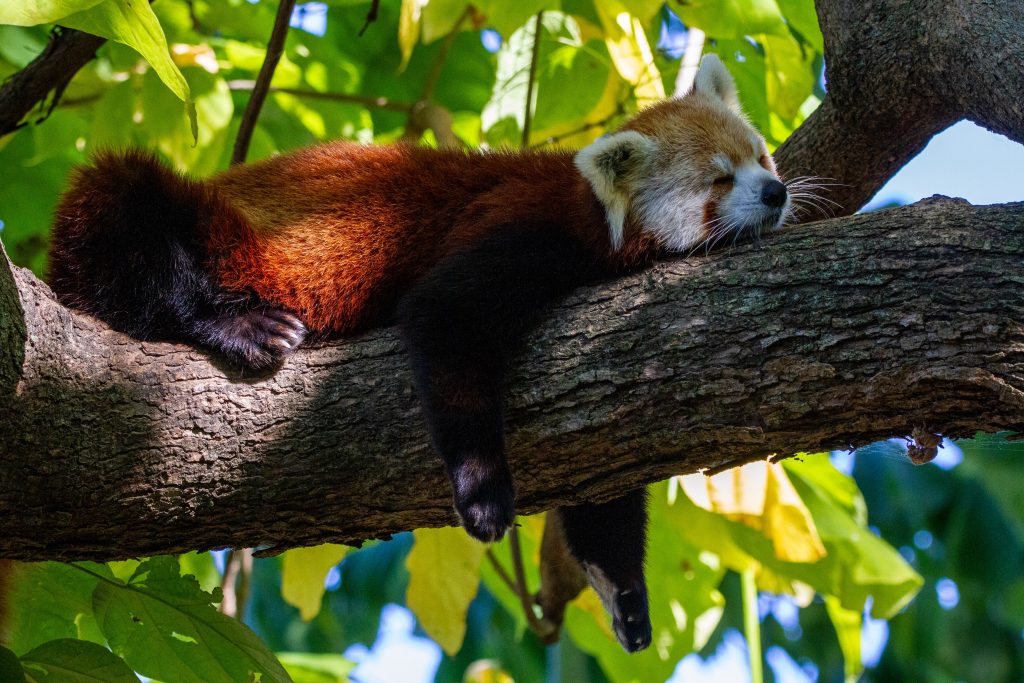
Until recently, Nepali movies tended to have lead characters who were extraordinary people who stood out from regular folks and were largely detached from their day-to-day lives. But popular actor Dayahang Rai, who started out in theatre and continues to invest time and energy there, has made a name for himself playing relatable characters with the same range of emotions as the rest of us.
Rai, from the eastern hill region of Nepal, also stands out from the rest of the celebrity pack in the Nepali film industry in another important way. Popularly known as Kazi, after the lovelorn character he played in the four-part Kabaddi movies set in the majestic trans-Himalayan region, Rai embraces a cause close to his heart: saving the country’s red pandas. He serves as the conservation ambassador for the Red Panda Network, an NGO working to save the endangered animal in Nepal.
Journalist Abhaya Raj Joshi caught up with Rai to talk about his role as a conservation ambassador and how cinema can help spread the message of conservation in Nepal.
Excerpts:

Let’s start with your experience so far volunteering as a red panda conservation ambassador. How’s the experience been so far?
It’s only been three years since I started out. I don’t expect my work to bring drastic changes in red panda conservation in a short period of time. To tell the truth, I don’t even know exactly how many red pandas there are in the wild in Nepal.
But I know for sure that something is happening to red pandas that’s increasing their risk of disappearing. This, I believe, can be attributed to human activities, which are influenced by many factors such as what we see and what we hear.
That’s where I thought I could play a role, however small it may be. I can reach the common people in a voice that they listen to, and I can convey the message that there’s an imbalance in nature that’s harming the red pandas and we need to do something about it.
In terms of scientific knowledge of the species, I’m barely scratching the surface. But I know for certain that red pandas need to coexist with humans, and they have important ecological roles to play.
In the larger scheme of things, humans take so much from nature, but we give back very little. That needs to change. This awareness also led me to take up the cause of the red pandas.
You come from the eastern hills of the country, known for being home to the red pandas. Have you ever seen them in the wild?
Unfortunately, I’ve only seen them in the zoo, not in the wild. But I plan to visit their habitat areas soon to get to see them in the flesh.
Tell us how your association with red pandas started.
Growing up in an agrarian village in eastern Nepal, I’ve always been inspired by nature in whatever I do, including acting. The gushing rivers, the placid lakes and forests full of fragrances give me the energy to do whatever I do. I’ve said this, and continue to say this, in the interviews I give to the media.
My colleagues from the Red Panda Network found this particularly interesting. They approached me to become an ambassador for red panda conservation. When I accepted their offer, I told them I wouldn’t be able to get into the scientific details of the animals, but with their backing and support, I can convey to my audience the urgency of the situation and contribute in my own way to conservation.
Celebrities in Nepal rarely take up causes related to conservation. Also, they mostly choose to remain silent on the various debates going on in society. Why so?
There might be several reasons. First, they don’t have the time to read up and keep themselves updated as they don’t have the backing of organisations such as the Red Panda Network to provide them with technical and scientific knowledge. The second reason is also closely associated with the first: they don’t have the time to delve into the nitty-gritty of big issues, and when they speak, they risk making superficial comments that don’t do any good.
In the case of red pandas, I don’t claim to know everything. But I can say that I can talk about whatever I know and remember from my interactions with conservationists and scientists.
Is there any memorable incident related to red pandas that you can count as an achievement after becoming an ambassador?
There have been many. But the one I remember the most is the call I received from my fans and supporters as well as government officials from my home district in eastern Nepal congratulating me for agreeing to work on red panda conservation. They had read reports in the media about it and they were very eager to work together.
You said that you have limited information on the science and technicalities behind red panda conservation. How challenging is it to disseminate this limited information to the public time and again?
It’s challenging. I need to make sure that whatever I say is factually correct and that I understand my limitations and boundaries. But the message I deliver is simple: red pandas are at risk of disappearing and that’s related to human activities. We need to restore the ecological balance so that the red pandas can coexist with humans.
You also use your social media accounts to promote red panda conservation. What’s the response from the audience like?
The response has been good. It’s a bit lukewarm compared to the responses we get for movie promotions and other activities. But people are listening and they’re understanding why it’s important.

Now let’s talk about the challenges in red panda conservation and how they relate to the movie industry. In a recent podcast, you pointed out that the illegal pelt trade and unplanned digging of roads in the hills are the major causes of concern. Could you explain?
I think it’s human nature that we want to collect things that are rare because we believe that if it’s rare it must be expensive. It’s the same with red pandas. As they’re so rare, there’s a false belief among people that their pelt is worth a fortune. But that’s not so.
Researchers have found out that there’s no actual market for red panda pelts internationally. So for anyone who kills red pandas for pelts, it’s like a game of hot potato in which you can’t hold on to the hot potato for a long time and need to pass it on to the next person. But when the whistle blows, the person holding the hot potato is in trouble. In the case of red panda pelts, traders pass on the pelt from one person to the other until someone gets caught by law enforcement.
The other issue is that people believe that they can earn a quick buck from tourists who come to see the red pandas, and that’s the only reason they want to save them.
As I said in the podcast, the digging of unplanned roads has become a major problem in Nepal. Whenever I go back to my village, I can reach home directly thanks to a new road. But during the rainy season, the road puts the entire settlement at risk from landslides.
Red pandas have their own paths and trails they use to look for food and find habitats and mates. But these roads are crisscrossing these trails and disturbing the movement of red pandas.
Can these issues inspire cinema to make people aware of what’s going on? Could such movies be commercially viable?
Yes, of course, these issues can inspire movies and even plays. We are in constant touch with the Red Panda Network to explore the possibilities. But we don’t have anything concrete to share as of now.
However, doing so is not without its challenges. Conservation along with red panda conservation is a sensitive issue and we need to get the science and the messaging right. The wrong messaging and inaccurate science can harm the cause rather than bolster it.
Conservation has already become a topic explored in cinema. We recently came up with a movie, Dui Numbari, dealing with the issue of poaching, hunting and human-leopard conflict. It did quite well commercially. But yes, it’s not adequate, we need more time to explore these issues as they’re relatively new.
What are some of the things you want to do for red panda conservation in the near future?
There’s a lot I want to do. But I also need to consider the time and resource constraints. The first thing I want to do is produce a theatre play to highlight the importance of red panda conservation. It won’t be something that will be groundbreaking or deliver drastic results, but it’ll be a start.
Also, we’ve noticed that there are different dance forms both in the east and west dedicated to different animals such as deer and tigers. But we haven’t come across anything related to red pandas, so maybe we’d want to develop that as well.
One final question: What would Kazi-dai do if he saw a red panda?
[Laughs.] Well, we’d never know. But as I share a soul with him, I can say for sure that he wouldn’t kill it. He’d rather admire its beauty.
This interview first appeared on Mongabay and Onlinekhabar is republishing it under a Creative Commons licence.





















